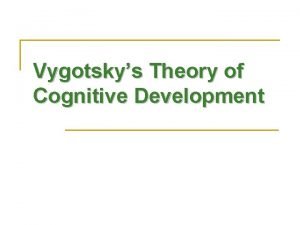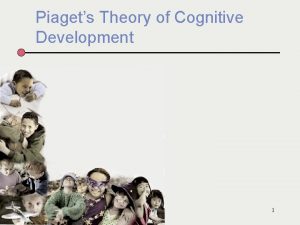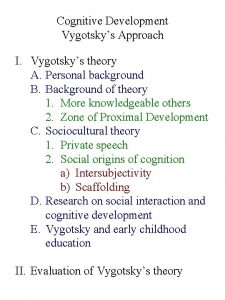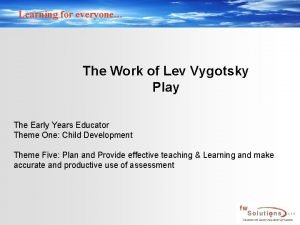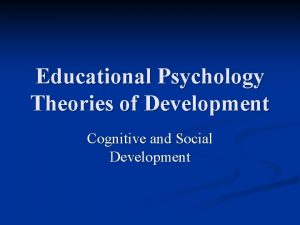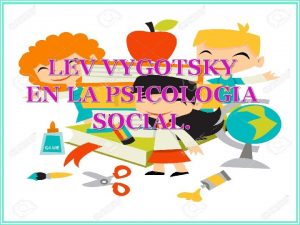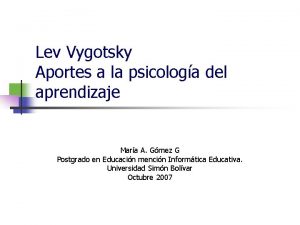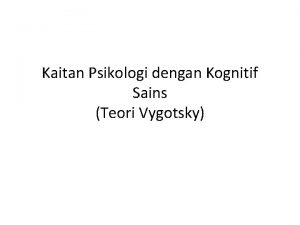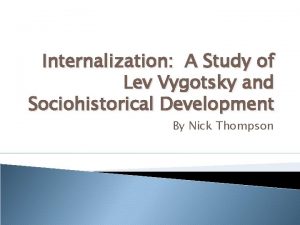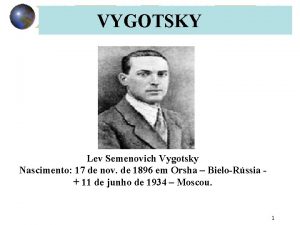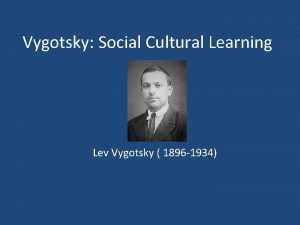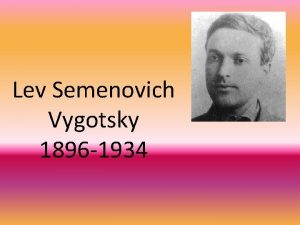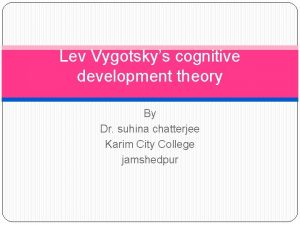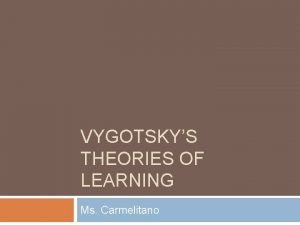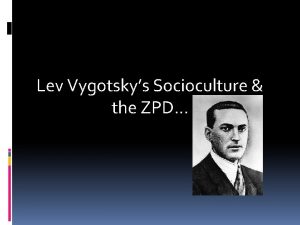Vygotskys Theory of Cognitive Development Lev Vygotsky 1896













- Slides: 13

Vygotsky’s Theory of Cognitive Development

Lev Vygotsky (1896– 1934) • Russian psychologist • Worked in post-revolutionary Soviet Union to rebuild psychology along Marxist lines • Applied psych. to problems confronting the new state, especially in the field of ed psych. • Worked to create theories of cognitive development

…. more Vygotsky n n Conducted research & writing during the same time as Piaget (1920’s & 1930’s) His writings were banned in the Soviet Union in 1936 & only became available in the west in the 1960’s q n His work became highly influential. He died of tuberculosis at the age of 38.

Vygotsky & Stalin n For 20 years after his death, it was forbidden to discuss, disseminate or reprint any of his writings His works could be read only in a single library in Moscow by special permission of the secret police After Stalin’s death, his writings were rediscovered

Vygotsky Continued n Different than Piaget’s image of the individual constructing understanding alone q n Everything is social Vygotsky saw cognitive development as depending more on interactions with people & tools in the child’s world. q q Tools are real: pens, paper, computers; or Tools are symbols: language, math systems, signs

The Big Ideas… n Explained complex learning through Guided Participation. q q q Explained things that are taught rather than discovered (reading, writing etc. ) a way to “share thinking load” Helping a novice accomplish a complex task Assistance can be physical or mental & come from adults or peers Scaffolding: where the more knowledgeable other provides some type of structure.

The Big Ideas… n Vygotsky developed theory of the Zone of proximal development (ZPD) q q The distance between where a learner is at developmentally on their own & where a learner could be with the help of a more knowledgeable other. A more knowledgeable other can be an adult or a peer, helping a learner in this way is to scaffold their learning.

Examples of Guided Participation n A mother sitting with her toddler singing, “Baa, baa black sheep have you any wool, yes sir …. ” at this point the mother pauses and the child sings loudly, “THREE BAGS FULL!”. q How is this guided participation?

Examples of Guided Participation n A 6 -year old lost a toy & asks her father for help. The father asks her where she last saw the toy; the child says , “I can’t remember. ” He asks a series of questions – “Did you have it in your room? Outside? ” To each question the child answers “No”. When he asks, “In the car? ”, she says “I think so” and finds the toy in the car. q In this story, who found the toy?

Examples of Guided Participation n Think back to your days of driver’s ed. and driving around with your parents and your temporary driver’s license. q In what ways did your parent or driving instructor provide guided participation for you?

Vygotsky and Schools n Emphasized social learning q We can often complete harder tasks with someone else than we could alone. n n Zone of Proximal Development q n Collaborative learning, group presentations, group work The teacher considers how much scaffolding to give a student to help them learn. A push for “authentic learning”. q Learning is tied to the context it is in.

Motivation & Vygotsky n This view emphasizes how people’s identities are formed by their participation in a group q q Students can be motivated to learn by participating in communities where learning is valued Ex: Children want to learn to read & write to become members of the “literary club”, to be able to participate and interact with the written world

Vygotsky’s Words… n “It is through others that we become ourselves” q n All learning is social “What a child can do in co-operation today he can do alone tomorrow” q Guided participation, ZPD, scaffolding
 Vygotsky's theory of cognitive development
Vygotsky's theory of cognitive development Vygotsky theory
Vygotsky theory Lev vygotsky (1896-1934)
Lev vygotsky (1896-1934) Celia moiseevna vigodskaya
Celia moiseevna vigodskaya Vygotskys theory
Vygotskys theory Lev vygotsky play theory
Lev vygotsky play theory How did vygotsky view cognitive development? *
How did vygotsky view cognitive development? * Lev vygotsky teoria
Lev vygotsky teoria Lev vygotsky aportes
Lev vygotsky aportes Vygotsky et le socioconstructivisme
Vygotsky et le socioconstructivisme Biografi vygotsky
Biografi vygotsky Internalization vygotsky
Internalization vygotsky Lev vygotsky nascimento
Lev vygotsky nascimento Jean piaget lev vygotsky
Jean piaget lev vygotsky
